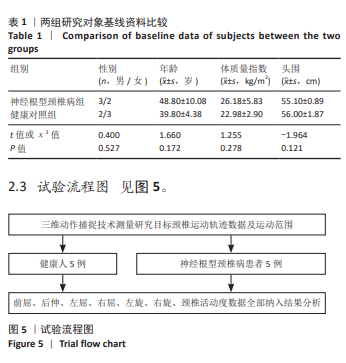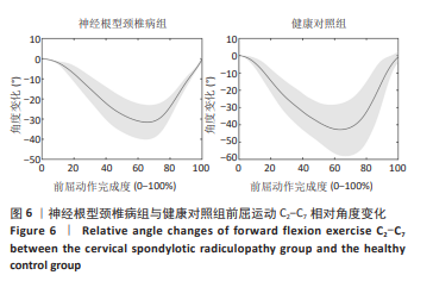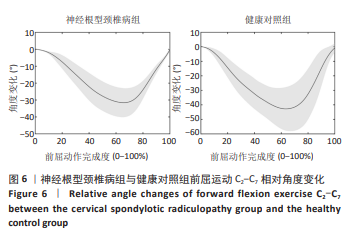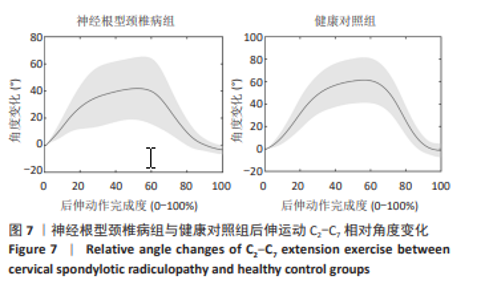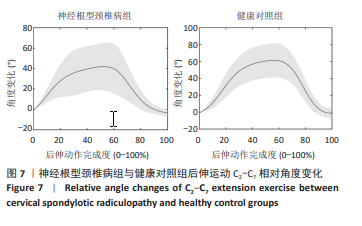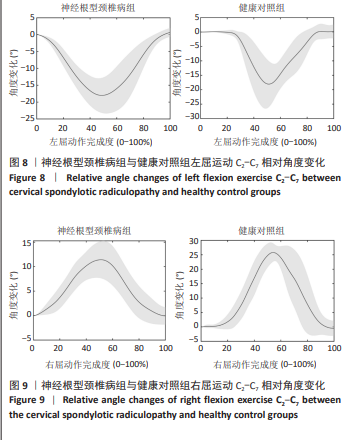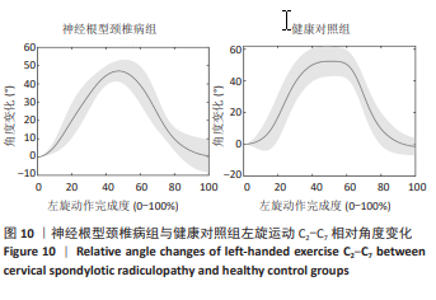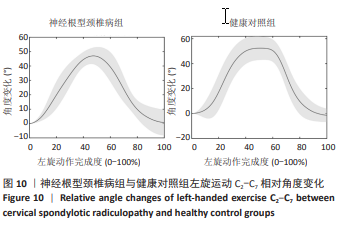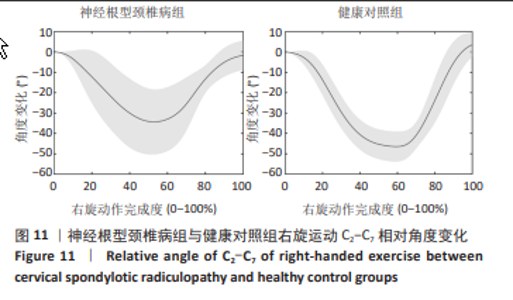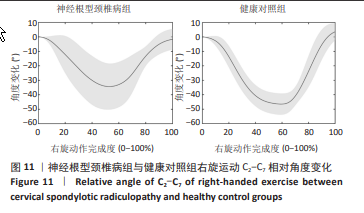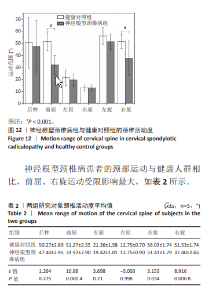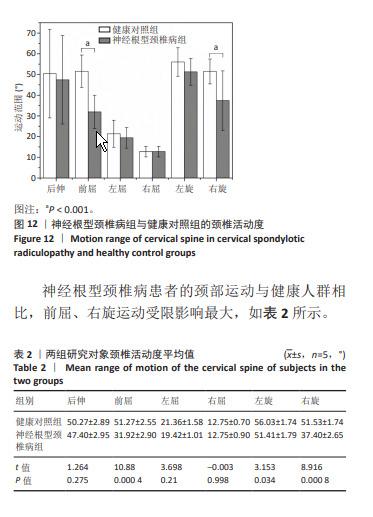Chinese Journal of Tissue Engineering Research ›› 2026, Vol. 30 ›› Issue (9): 2286-2293.doi: 10.12307/2026.543
Previous Articles Next Articles
Cervical motion characteristics in patients with cervical spondylotic radiculopathy based on motion capture technology
Li Zhifei1, 2, Han Bin1, Liu Qiuli1, Zhang Zhanming1, Wei Haokai1, Zuo Kuangshi1, Zhang Yisheng1, 2
- 1Graduate School of Guangxi University of Chinese Medicine, Nanning 530004, Guangxi Zhuang Autonomous Region, China; 2First Affiliated Hospital of Guangxi University of Chinese Medicine, Nanning 530023, Guangxi Zhuang Autonomous Region, China
-
Received:2024-11-27Accepted:2025-02-11Online:2026-03-28Published:2025-09-06 -
Contact:Zhang Yisheng, Doctoral candidate, Attending physician, Graduate School of Guangxi University of Chinese Medicine, Nanning 530004, Guangxi Zhuang Autonomous Region, China; First Affiliated Hospital of Guangxi University of Chinese Medicine, Nanning 530023, Guangxi Zhuang Autonomous Region, China -
About author:Li Zhifei, Doctoral candidate, Chief physician, Graduate School of Guangxi University of Chinese Medicine, Nanning 530004, Guangxi Zhuang Autonomous Region, China; First Affiliated Hospital of Guangxi University of Chinese Medicine, Nanning 530023, Guangxi Zhuang Autonomous Region, China -
Supported by:Guangxi Natural Science Foundation (General Project), No. 2022JJA140858 (to LZF)
CLC Number:
Cite this article
Li Zhifei, Han Bin, Liu Qiuli, Zhang Zhanming, Wei Haokai, Zuo Kuangshi, Zhang Yisheng. Cervical motion characteristics in patients with cervical spondylotic radiculopathy based on motion capture technology[J]. Chinese Journal of Tissue Engineering Research, 2026, 30(9): 2286-2293.
share this article
Add to citation manager EndNote|Reference Manager|ProCite|BibTeX|RefWorks
| [1] 张琪,马信龙,赵娜,等.青年颈椎病患者中医外治法研究进展[J].中国中西医结合外科杂志,2024,30(4):585-588. [2] 储浩然,胡进,孙奎,等.针灸治疗神经根型颈椎病临床实践指南[J].世界针灸杂志(英文版),2017,27(1):3-11. [3] 许金海.上海城市人群颈椎病流行病学调查及筋痹颗粒治疗神经根型颈椎病的临床研究[D].上海:上海中医药大学,2019. [4] 徐善达,孔令军,朱清广,等.颈型颈椎病“筋骨失衡”的运动学特性研究[J].中华中医药杂志,2020,35(9):4739-4742. [5] 中华外科杂志编辑部.颈椎病的分型、诊断及非手术治疗专家共识(2018)[J].中华外科杂志,2018,56(6):401-402. [6] 周逸彬,李西成.C2-C7活动度预测脊髓型颈椎病症状严重程度的临床价值[J].颈腰痛杂志,2020,41(1):45-47. [7] TSAI MC, LIU YF, LIN WH, et al. Restoration of Range of Motion in the Cervical Spine through Single-Segment Artificial Disc Replacement Using the Baguera®C Prosthesis. J Clin Med. 2024;13(7):2048. [8] GRIDER-POTTER N, NALLEY TK, THOMPSON NE, et al. Influences of passive intervertebral range of motion on cervical vertebral form. Am J Phys Anthropol. 2020;172(2):300-313. [9] ZHANG JT, MENG FT, WANG S, et al. Predictors of surgical outcome in cervical spondylotic myelopathy: focusing on the quantitative signal intensity. Eur Spine J. 2015;24(12):2941-2945. [10] INOKUCHI H, TOJIMA M, MANO H, et al. Neck range of motion measurements using a new three-dimensional motion analysis system: validity and repeatability. Eur Spine J. 2015;24(12):2807-2815. [11] CARVALHO GF, CHAVES TC, GONÇALVES MC, et al. Comparison between neck pain disability and cervical range of motion in patients with episodic and chronic migraine: a cross-sectional study. J Manipulative Physiol Ther. 2014;37(9):641-646. [12] 牛灵芝,蔡龙龙,卢媛媛,等.颈椎病X线片的特点与分析[J].世界最新医学信息文摘,2019,19(74):203,215. [13] 蔡旭,康健,陈欣,等.基于CT三维重建的上颈椎三维活动度在体测量研究[J].中国骨伤,2019,32(7):658-665. [14] 陈壹凡.颈椎CT三维重建在ACDF中自体原位取骨及融合情况评估的量化研究[D].广州:南方医科大学,2024. [15] 宋辉,李浩鹏,高中洋,等.颈椎活动度测量的研究现状及进展[J].生物骨科材料与临床研究,2017,14(5):63-69. [16] TOUSIGNANT M, BOUCHER N, BOURBONNAIS J, et al. Intratester and intertester reliability of the Cybex electronic digital inclinometer (EDI-320) for measurement of active neck flexion and extension in healthy subjects. Man Ther. 2001;6(4):235-241. [17] VÁSQUEZ-UCHO PA, VILLALBA-MENESES GF, PILA-VARELA KO, et al. Analysis and evaluation of the systems used for the assessment of the cervical spine function: a systematic review. J Med Eng Technol. 2021;45(5):380-393. [18] 帕哈提·吐逊江,杨来红,等.影像组学在脊柱疾病中的应用[J].磁共振成像,2022,13(5):162-166. [19] CHALIMOURDAS A, DIMITRIADIS Z, KAPRELI E, et al. Test - re-test reliability and concurrent validity of cervical active range of motion in young asymptomatic adults using a new inertial measurement unit device. Expert Rev Med Devices. 2021;18(10):1029-1037. [20] 杨艺,贺晓阳.基于改进MEMS惯性传感器的人体动作智能捕捉[J].计算机仿真,2024,41(1):247-250+260. [21] FENG M, LIANG L, SUN W, et al. Measurements of cervical range of motion using an optical motion capture system: Repeatability and validity. Exp Ther Med. 2019;18(6):4193-4202. [22] MORENO AJ, UTRILLA G, MARIN J, et al. Cervical Spine Assessment Using Passive and Active Mobilization Recorded Through an Optical Motion Capture. J Chiropr Med. 2018;17(3):167-181. [23] 陈雁超.基于惯性传感器的单点感测与动作识别[D].重庆:重庆大学,2022. [24] PRASERTSAKUL T, THUMVIVATNUKUN C, CHARTVIVATPORNCHAI S, et al. Effectiveness of Different Cervical Range of Motion Measurement Techniques for Home-Use to Prevent Cervical Spondylosis. Annu Int Conf IEEE Eng Med Biol Soc. 2023;2023:1-4. [25] KATO S, FUJIWARA S, OHTOMO N, et al. Motion Capture-based 3-Dimensional Measurement of Range of Motion in Patients Undergoing Cervical Laminoplasty. Clin Spine Surg. 2025;38(1):E24-E29. [26] BARRETT JM, MCKINNON CD, DICKERSON CR, et al. An Electromyographically Driven Cervical Spine Model in OpenSim. J Appl Biomech. 2021;37(5):481-493. [27] 胥少汀,葛宝丰,卢世壁,等.实用骨科学(第四版修订本)[M].郑州:河南科学技术出版社,2019. [28] LEVASSEUR CM, WAWROSE R, PITCAIRN S, et al. Dynamic functional nucleus is a potential biomarker for structural degeneration in cervical spine discs. J Orthop Res. 2019;37(4):965-971. [29] LINDENMANN S, TSAGKARIS C, FARSHAD M, et al. Kinematics of the Cervical Spine Under Healthy and Degenerative Conditions: A Systematic Review. Ann Biomed Eng. 2022;50(12):1705-1733. [30] ZHOU C, WANG H, WANG C, et al. Intervertebral range of motion characteristics of normal cervical spinal segments (C0-T1) during in vivo neck motions. J Biomech. 2020;98:109418. [31] TANG C, LIAO YH, WANG Q, et al. The association between unilateral high-riding vertebral artery and atlantoaxial joint morphology: a multi-slice spiral computed tomography study of 396 patients and a finite element analysis. Spine J. 2023;23(7):1054-1067. [32] 黄盛佳,肖红卫,李剑锋,等.健康人下颈椎的有限元模型构建及分析[J].医药前沿,2024,14(5):19-22. [33] 金丹.包含寰枕和寰枢关节的颈部模型建模与验证[D].长春:吉林大学,2020. [34] 侯黎升,白雪东,葛丰,等.颈部屈伸运动时上下颈椎的矢状面运动特点[J].实用骨科杂志,2018,24(7):660-665. [35] 茆军兵,贾晓红,王人成,等.头部前屈运动过程中颈肌特性的研究[J].医用生物力学,2012,27(5):577-581. [36] MITSUTAKE T, SAKAMOTO M, CHYUDA Y, et al. Greater Cervical Muscle Fat Infiltration Evaluated by Magnetic Resonance Imaging is Associated With Poor Postural Stability in Patients With Cervical Spondylotic Radiculopathy. Spine (Phila Pa 1976). 2016;41(1):E8-E14. [37] HUANG L, CHUN KS, YU L, et al. A Novel Method for Tracking Neck Motions Using a Skin-Conformable Wireless Accelerometer: A Pilot Study. Digit Biomark. 2024;8(1):40-51. [38] KULKARNI P, AGRAWAL SK. Design and Validation of a Novel Robotic Neck Brace for Cervical Traction. IEEE ASME Trans Mechatron. 2024; 29(4):3092-3099. [39] HOSSEINI MM, MAHOOR MH, HAAS JW, et al. Intra-Examiner Reliability and Validity of Sagittal Cervical Spine Mensuration Methods Using Deep Convolutional Neural Networks. J Clin Med. 2024;13(9):2573. [40] EL-GOHARY M, MCNAMES J. Human Joint Angle Estimation with Inertial Sensors and Validation with A Robot Arm. IEEE Trans Biomed Eng. 2015;62(7):1759-1767. [41] SLADE P, HABIB A, HICKS JL, et al. An Open-Source and Wearable System for Measuring 3D Human Motion in Real-Time. IEEE Trans Biomed Eng. 2022;69(2):678-688. [42] HOSSAIN MSB, DRANETZ J, CHOI H, et al. DeepBBWAE-Net: A CNN-RNN Based Deep SuperLearner for Estimating Lower Extremity Sagittal Plane Joint Kinematics Using Shoe-Mounted IMU Sensors in Daily Living. IEEE J Biomed Health Inform. 2022;26(8):3906-3917. |
| [1] | Pan Hongfei, Zhuang Zhenbing, Xu Baiyun, Yang Zhangyang, Lin Kairui, Zhan Bingqing, Lan Jinghan, Gao Heng, Zhang Nanbo, Lin Jiayu. Inhibitory effects of different concentrations of auranofin on M1 macrophage function and its therapeutic potential in diabetic wound healing [J]. Chinese Journal of Tissue Engineering Research, 2026, 30(6): 1390-1397. |
| [2] | Peng Zhiwei, Chen Lei, Tong Lei. Luteolin promotes wound healing in diabetic mice: roles and mechanisms [J]. Chinese Journal of Tissue Engineering Research, 2026, 30(6): 1398-1406. |
| [3] | Cao Xinyan, Yu Zifu, Leng Xiaoxuan, Gao Shiai, Chen Jinhui, Liu Xihua. Effect of repetitive transcranial magnetic stimulation and transcranial direct current stimulation on motor function and gait in children with cerebral palsy: a network meta-analysis [J]. Chinese Journal of Tissue Engineering Research, 2026, 30(6): 1539-1548. |
| [4] | Guo Ying, Tian Feng, Wang Chunfang. Potential drug targets for the treatment of rheumatoid arthritis: large sample analysis from European databases [J]. Chinese Journal of Tissue Engineering Research, 2026, 30(6): 1549-1557. |
| [5] | Sun Yajie, Zhao Xinchen, Bo Shuangling. Spatiotemporal expression of bone morphologic protein 7 in mouse kidney development [J]. Chinese Journal of Tissue Engineering Research, 2026, 30(5): 1156-1161. |
| [6] | Li Haojing, Wang Xin, Song Chenglin, Zhang Shengnan, Chen Yunxin. Therapeutic efficacy of extracorporeal shock wave therapy in the upper trapezius muscle area combined with exercise control training in patients with chronic non-specific neck pain [J]. Chinese Journal of Tissue Engineering Research, 2026, 30(5): 1162-1170. |
| [7] | Liu Yu, Lei Senlin, Zhou Jintao, Liu Hui, Li Xianhui. Mechanisms by which aerobic and resistance exercises improve obesity-related cognitive impairment [J]. Chinese Journal of Tissue Engineering Research, 2026, 30(5): 1171-1183. |
| [8] | Yu Huifen, Mo Licun, Cheng Leping. The position and role of 5-hydroxytryptamine in the repair of tissue injury [J]. Chinese Journal of Tissue Engineering Research, 2026, 30(5): 1196-1206. |
| [9] | Wang Zhengye, Liu Wanlin, Zhao Zhenqun. Advance in the mechanisms underlying miRNAs in steroid-induced osteonecrosis of the femoral head [J]. Chinese Journal of Tissue Engineering Research, 2026, 30(5): 1207-1214. |
| [10] | Bu Yangyang, Ning Xinli, Zhao Chen. Intra-articular injections for the treatment of osteoarthritis of the temporomandibular joint: different drugs with multiple combined treatment options [J]. Chinese Journal of Tissue Engineering Research, 2026, 30(5): 1215-1224. |
| [11] | Wen Fan, Xiang Yang, Zhu Huan, Tuo Yanfang, Li Feng. Exercise improves microvascular function in patients with type 2 diabetes [J]. Chinese Journal of Tissue Engineering Research, 2026, 30(5): 1225-1235. |
| [12] | Liu Xinyue, Li Chunnian, Li Yizhuo, Xu Shifang. Regeneration and repair of oral alveolar bone defects [J]. Chinese Journal of Tissue Engineering Research, 2026, 30(5): 1247-1259. |
| [13] | Leng Xiaoxuan, Zhao Yuxin, Liu Xihua. Effects of different neuromodulatory stimulation modalities on non-motor symptoms in Parkinson’s patients: a network meta-analysis [J]. Chinese Journal of Tissue Engineering Research, 2026, 30(5): 1282-1293. |
| [14] | Wen Xiaolong, Weng Xiquan, Feng Yao, Cao Wenyan, Liu Yuqian, Wang Haitao. Effects of inflammation on serum hepcidin and iron metabolism related parameters in patients with type 2 diabetes mellitus: a meta-analysis [J]. Chinese Journal of Tissue Engineering Research, 2026, 30(5): 1294-1301. |
| [15] | Yang Zeyu, Zhi Liang, Wang Jia, Zhang Jingyi, Zhang Qingfang, Wang Yulong, Long Jianjun. A visualized analysis of research hotspots in high-frequency repetitive transcranial magnetic stimulation from the macroscopic perspective [J]. Chinese Journal of Tissue Engineering Research, 2026, 30(5): 1320-1330. |
| Viewed | ||||||
|
Full text |
|
|||||
|
Abstract |
|
|||||

